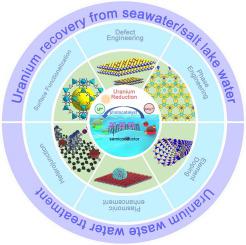Coordination Chemistry Reviews ( IF 20.3 ) Pub Date : 2022-05-18 , DOI: 10.1016/j.ccr.2022.214615 Tao Chen , Kaifu Yu , Changxue Dong , Xin Yuan , Xiang Gong , Jie Lian , Xin Cao , Mingzhe Li , Li Zhou , Baowei Hu , Rong He , Wenkun Zhu , Xiangke Wang

|
Nuclear energy has been regarded as one of the promising energy sources to replace traditional fossil fuels due to its advantages of high energy density and carbon-free emission. Unfortunately, the limited storage of uranium ore restricted the sustainable development of nuclear energy, together with the generation of uranium-containing wastewater resulting in the problems of environmental pollution. Therefore, extracting and recycling uranium from seawater and radioactive uranium-containing wastewater is necessary for the sustainable development of nuclear energy and environmental protection. The light-driven heterogeneous photocatalytic technology is an appealing strategy to significantly promote the kinetics, capacity, and selectivity during uranium extraction. However, the recovery of uranium from radioactive wastewater/seawater is restricted by various factors, such as abundant competing ions, low uranium concentration, coexisting organic matter, and strong acidity or alkalinity in special environmental in the process of practical application. In this review, we described the general background of uranium extraction, followed by a brief discussion of the several possible reduction paths for photocatalytic reduction of uranium. Then, the effects of experimental conditions, photocatalyst stability and environmental adaptability on the performance of photocatalytic uranium reduction were systematically discussed. After having some fundamental understanding on photocatalytic uranium reduction, we summarized the design guidelines of photocatalysts for uranium reduction, and further discussed the corresponding advantages and disadvantages in photocatalytic uranium reduction. In addition, we concluded the current available characterization techniques for identifying uranium species after reduction, which is critical to the mechanistic study. Finally, we end this review with an outlook into the remaining challenges and future perspectives of photocatalytic uranium reduction.
中文翻译:

先进的铀提取光催化剂:精心设计和未来展望
核能由于具有能量密度高、无碳排放等优点,被认为是替代传统化石燃料的有希望的能源之一。不幸的是,铀矿石的有限储存限制了核能的可持续发展,同时产生含铀废水,造成环境污染问题。因此,从海水和含放射性铀的废水中提取和回收铀是核能可持续发展和环境保护的必要条件。光驱动多相光催化技术是一种有吸引力的策略,可显着提高铀提取过程中的动力学、容量和选择性。然而,从放射性废水/海水中回收铀在实际应用过程中受到竞争离子丰富、铀浓度低、有机物共存、特殊环境强酸强碱等多种因素的制约。在这篇综述中,我们描述了铀提取的一般背景,然后简要讨论了铀光催化还原的几种可能的还原途径。然后,系统地讨论了实验条件、光催化剂稳定性和环境适应性对光催化铀还原性能的影响。在对光催化铀还原有一些基本了解后,我们总结了铀还原光催化剂的设计指南,并进一步讨论了光催化铀还原的相应优缺点。此外,我们总结了目前可用于鉴定还原后铀物种的表征技术,这对机理研究至关重要。最后,我们以对光催化铀还原的剩余挑战和未来前景的展望结束本次审查。











































 京公网安备 11010802027423号
京公网安备 11010802027423号